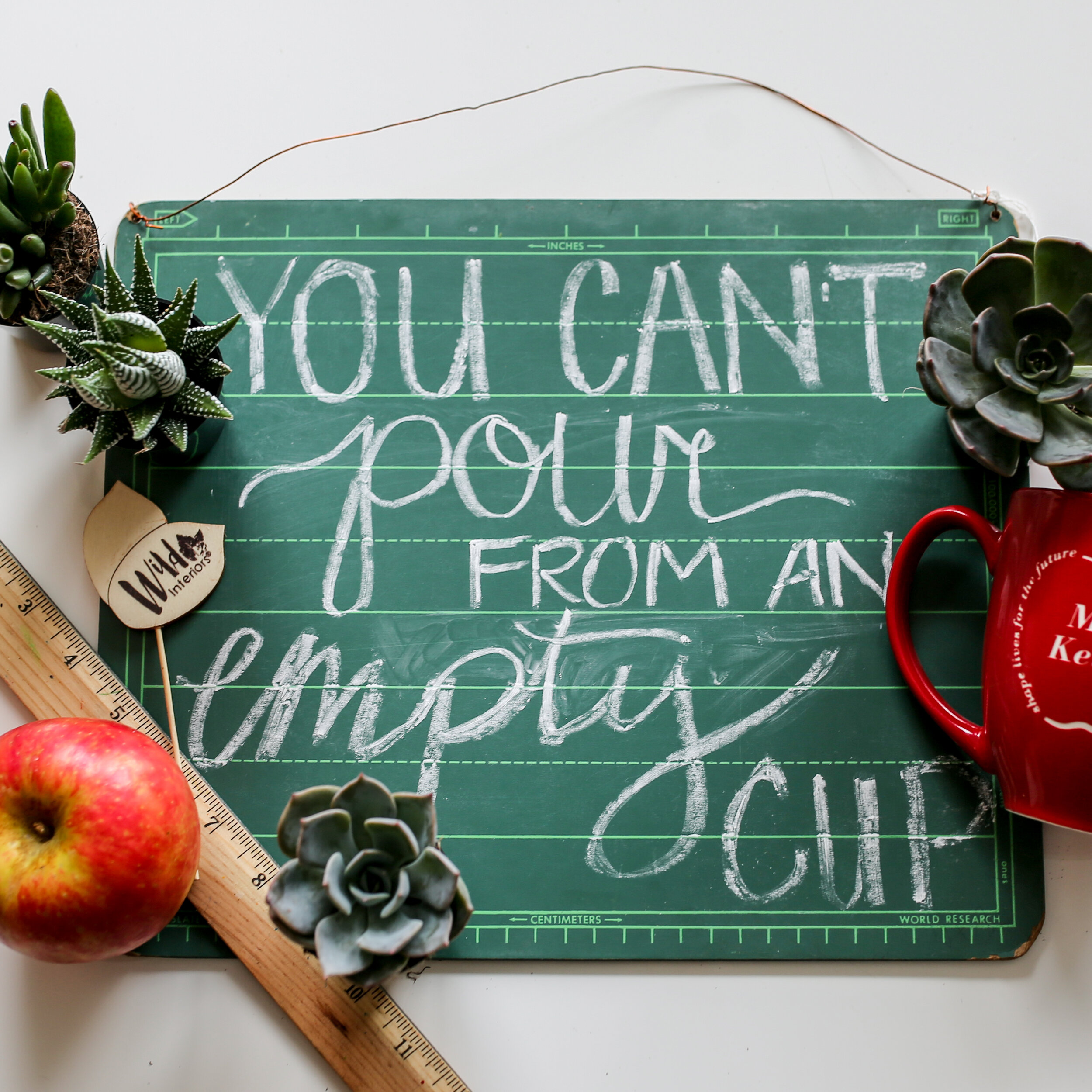Self Care for Teachers - Practical Tips from Real Educators
It’s back to school season, whether or not you’re returning to the classroom. Though things look different for this school year, there’s one fact that’s at the heart of every school year: teachers are incredible assets to their communities and often go above and beyond to help their students succeed. But sometimes above and beyond becomes too much of a good thing. Just like a plant that doesn’t get the proper light, water, and nutrients, people need to get the care they need in order to flourish and help themselves and others grow.
This one’s for the teachers!
As schools closed this spring, you might have been feeling confused, nervous, and scared - and so did your students. It’s okay to not feel like everything’s okay or normal, and your students will probably look to you for guidance and reassurance on how to manage their feelings too.
We asked educators to share their tips for self care that all teachers can use, even if you’re not sure what to expect this year. These ideas range from planning for the unplannable to setting up your home office for distance teaching, and we’ve even got tips for homeschooling parents!
We hope these self care tips help you find little ways to take care of yourself in one of the most important jobs out there.
Self Care for Your Anxiety
Worried about re-opening, or trying to do a great job in a new “normal”? It’s ok to be nervous and not know exactly what you’re doing. The new guidelines for safety during the COVID-19 pandemic are creating new habits for all of us, even though things may change from week to week. There are ways to plan for some things even facing down the uncertainty of the details.
Jess R., a special education teacher from Washington, DC says:
“We know some things we can plan. We know we’ll need a way to contact parents easily and efficiently, whether through a school-provided method or online learning like a Google Classroom. We know we have feelings about distance learning from the spring, so reflect on what went right and what was challenging during that time, so you and your fellow teachers and administrators can make a plan to streamline the transition plan for the fall. What can you personally do to get ahead of some of those problems? We know things are going to be different, so practice flexibility.”
To put her advice to use, try making a list of everything you need to plan for to start school this year. Then decide what you can control or plan for, and what you can’t. When you start to feel anxious or overwhelmed, refer back to the list and remember that you’re in control as much as possible and it’s okay that not everything is certain.
You can also try some mindfulness exercises. Practice them now so that you can have one or two easy favorites you can use when tensions run high during class. Breathing exercises, positive affirmations, or even an inconspicuous pressure point massage on your hands can help ground you and keep you feeling centered. Check out our blog on self-care mindfulness practices for help getting started.
Self Care for Your Work-Life Balance
If you’re doing distance learning, just because you’re working from home doesn’t mean work never ends! Set limits on the hours you’ll check and respond to emails that aren’t emergencies, and practice not feeling bad about it. It’s easy to lose yourself and your boundaries when you know there are others feeling the same stress, but you need to protect your own peace too, when you can. (This is true if you’re working on-site, too).
Managing your workload and schedule can be stressful, whether you’re doing distance learning or on-site teaching. Find an organization routine that works for you. Whether that’s sticky notes, a bullet journal, scheduling blocks in your online calendar, or making a classic to-do list, getting things done on time can be hard when the days blend together so easily. Virginia H., a teacher from Washington, D.C., says “I write everything down so I can check the boxes,” and it can be as simple as that to help organize your tasks.
Finally, to maintain a healthy balance between work and life, it means you need to have things in your life besides work! This can be challenging when you can’t go out and do social activities like you used to, so try a new hobby - and schedule time for it. Practice doing something that brings you joy and lets you unwind, and don’t shy away from sharing about it with your students to let them know they should be practicing their hobbies too! Maybe you’ve spent the summer getting into houseplants, or you’ve always wanted to learn guitar or get back into painting after all these years.
How to Set Up a Home Office for Productivity and Self-Care
If you’re working remotely, make sure your home office is set up for success so your space looks great on video calls and you can enter your space ready to work. Don’t forget about the benefits of houseplants in your home office! Houseplants boost your mood and productivity, help clean the air, and look great on and off camera. Check out our tips to design your home office with houseplants for productivity.
To maintain that productive energy, schedule breaks for yourself and stick to a routine to separate your work time from your you-time. Your home office is a great place to work, but you also need to get a break from it just like you would at work. Cook a fresh meal on your lunch break, go for a walk around the block, or take your computer to another room for one of your lessons to break things up and get a change of scenery.
Your students need breaks during the day too, so build de-stressing time into your lessons, like a quick dance break, a time for socializing, or even an opportunity for them to give a tour of their home on camera.
Self-Care for Homeschooling Parents
Whether you’re facilitating your school’s curriculum through distance learning or you’re a full time homeschooler following your own curriculum, homeschooling during COVID isn’t like other years and brings its own challenges.
Veteran homeschooler Coróin N. from Warren, Ohio has an important reminder:“You’re not homeschooling, you’re doing your best under impossible circumstances.” This isn’t normal homeschooling, which usually has opportunities to visit museums or events that aren’t available during COVID-19. We’re all in this together and it’s a challenge.
Here are some more great tips from Coróin to help parents set up a conducive learning environment at home without sacrificing their inner peace:
Adjust Bedtime: An earlier than normal bedtime takes a bit of adjustment, but can result in better attitudes during the day as well as create much-needed grownups-only time in the evenings.
Encourage Independent Learning: Just because you’re home together doesn’t mean you need to be hands-on all day. Provide access to educational materials and leave them to it while you go about your day, keeping an eye and ear out for kids who need urgent attention. Check out zoos and aquariums for online livestreams, or animal preserve videos on YouTube.
Be Honest: Don’t shy away from explaining the circumstances of the school year to your children. Explain in age-appropriate language what’s going on in the world. Children that know the score are less likely to test your boundaries because they understand that things are stressful for everyone.
Learning is Everywhere: Coróin says, “Understand that your children’s brains are little information seeking machines and as long as they’re learning something, those mental muscles will stay active. Baking and cooking are math and science, and can be social studies and history and comparative cultural awareness depending on what you make. Gardening is life skills and patience and delayed gratification and the importance of daily care routines, as well as life sciences and understanding where your food comes from. Roasting marshmallows is science. Stargazing is astronomy. Anything can be school; it doesn’t have to look like it does in the building you used to take them to. You and they will suffer for trying to replicate school exactly at home.” Check out our plant activities for kids to add a botany lesson to your plan!
Practice Self-Care: Lastly, don’t forget that you still need to prioritize your own needs. It’s impossible to do everything perfectly between educating children at home, working from home, managing the household needs, etc. So cut yourself some slack and breathe! If you’re not taking care of yourself, you’re not going to have anything for the kids either.
From setting up your home office with plants for productivity to just making sure you’re taking the time for you to find peace in the chaos, self care for teachers is a must for your back to school planning.
Keep track of your self care habits with our self care bullet journal pages, available for download when you sign up for our email newsletter!

